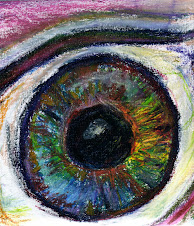If you can easily coordinate both of your eyes to point to the same place at the same time, you are unlikely to have this problem. However, if you can't, you may find reading very frustrating because the words may appear to wiggle or double up on the page so that it is very difficult to decode them. When this happens to beginning readers, the situation is more difficult because these very young children do not usually have the experience of normal single vision so they don't know that what they are seeing when they read is abnormal. They also don't have the language to explain what is happening. It is especially difficult for very bright, obviously articulate children who cannot counter the grown-ups' assertions that they are not trying hard enough.
Here is a simple test that anyone can do at home to check how well their eyes can team. It is called a pencil push-up. Hold a pencil in front of your face about arm's length away and slightly below your nose. Try to focus both eyes on the writing on the pencil keeping it clear. Slowly pull the pencil towards your nose, keeping the letters clear. Can you pull the pencil to within an inch of your nose without it becoming blurred or doubled? That is normal. If the pencil doubles or gets so blurry that you cannot see the writing, you should go to a developmental optometrist who specializes in binocular vision and who incorporates vision therapy into their practice.
If you sit opposite the person who is doing the pencil push-up, watch their eyes. You should see them move closer and closer towards the nose as if they are becoming "crossed." You may notice that one or both eyes suddenly stop crossing and bleep out towards the ears. When this happens, the person will probably report that they see two pencils. That is because the eyes stopped teaming to point to the same place in space at the same time so the brain received two separate visual images instead of one fused image with depth and detail.
This could be due to a condition called convergence insufficiency. Recent research demonstrates that it takes an average of 12 in-office sessions of vision therapy to address a convergence insufficiency. There are even some computer programs that can be purchased to address eye teaming problems at home which can be used in conjunction with in-office vision therapy with some patients who have adequate stereo vision.
So, don't accuse your child of being lazy if they report that the words wiggle or look double or blurry. Take them to a developmental optometrist who will be able to provide therapeutic interventions to address the problem in a few short months afterwhich reading should become much more efficient and enjoyable.
Subscribe to:
Post Comments (Atom)





No comments:
Post a Comment